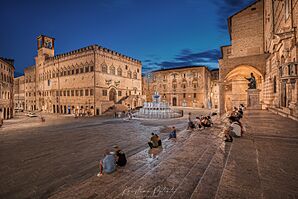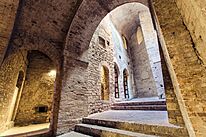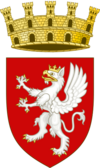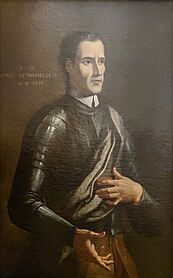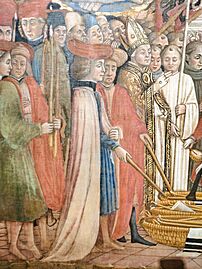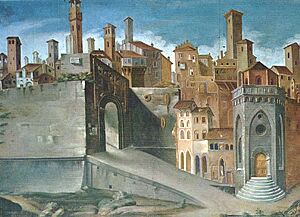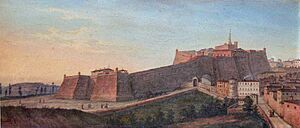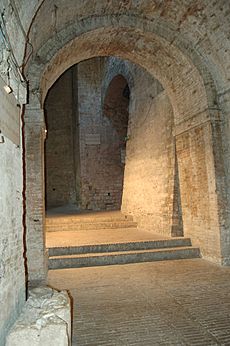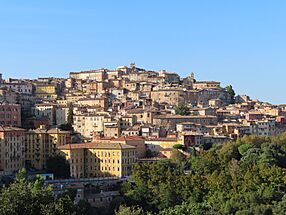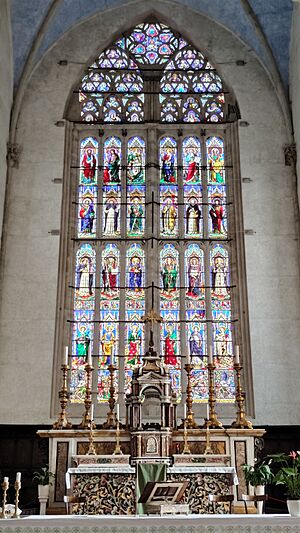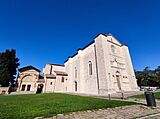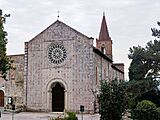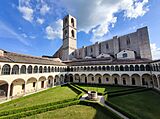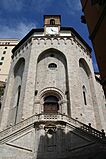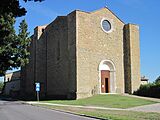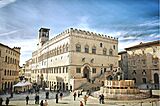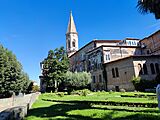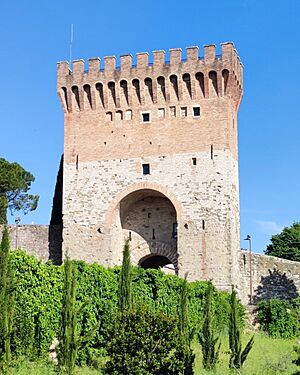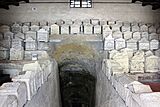Perugia facts for kids
Quick facts for kids
Perugia
|
|||
|---|---|---|---|
| Comune di Perugia | |||
|
Panorama of Piazza IV Novembre
Etruscan Arch
Basilica San Domenico
Torre del Cassero
Basilica San Pietro
Rocca Paolina
Perugia from Porta Sole
|
|||
|
|||
| Country | Italy | ||
| Region | Umbria | ||
| Province | Perugia (PG) | ||
| Frazioni | See list | ||
| Area | |||
| • Total | 449.5 km2 (173.6 sq mi) | ||
| Elevation | 493 m (1,617 ft) | ||
| Population
(30 June 2023)
|
|||
| • Total | 161,228 | ||
| • Density | 358.68/km2 (928.98/sq mi) | ||
| Demonym(s) | Perugino | ||
| Time zone | UTC+1 (CET) | ||
| • Summer (DST) | UTC+2 (CEST) | ||
| Postal code |
06100
|
||
| Dialing code | 075 | ||
| Patron saint | St. Constantius, St. Herculanus, St. Lawrence | ||
| Saint day | 29 January | ||
Perugia is a historic city in central Italy. It is the capital of the Umbria region. The city sits on a high hilltop, with valleys around it. It is about 164 kilometers (102 miles) north of Rome. It is also 148 kilometers (92 miles) southeast of Florence.
Perugia has a very long history. It dates back to the Etruscan period. It was one of the most important Etruscan cities.
Today, Perugia is known as a university town. The University of Perugia was started in 1308. There is also the University for Foreigners. This university teaches Italian language and culture to students from all over the world. Other schools include the Academy of Fine Arts and the Music Conservatory.
The city is also a famous cultural and art center in Italy. It hosts many yearly festivals. These include the Umbria Jazz Festival in July. The International Journalism Festival happens in April. Many famous artists have connections to Perugia.
Pietro Vannucci, known as Perugino, was a famous painter from nearby. He decorated the Sala del Cambio with beautiful frescoes. Eight of his paintings are in the National Gallery of Umbria. Perugino was even the teacher of Raphael, a great Renaissance artist. Another painter, Pinturicchio, lived in Perugia. Galeazzo Alessi was a famous architect from the city.
The symbol of Perugia is the griffin. You can see statues and plaques of griffins on buildings. It is also the symbol of the local football club, A.C. Perugia. This team once played in Italy's top league. In the 1978–79 season, they finished second without losing a single game!
Contents
- Exploring Perugia's Past
- Perugia's Economy
- Geography and Climate
- People of Perugia
- Learning and Education
- Frazioni: Towns and Villages
- Amazing Places to See
- Festivals and Events
- Famous People from Perugia
- Sports in Perugia
- Getting Around Perugia
- Perugia's Sister Cities
- Images for kids
- See also
Exploring Perugia's Past
Ancient Roots: Umbrians and Etruscans
Perugia was first a settlement of the Umbri people. It later became known as Perusia. This was one of the 12 main cities of the Etruscan League. The city was first mentioned around 310 or 309 BC. At that time, it agreed to a 30-year truce. However, Perugia later joined the Third Samnite War. It was then forced to ask for peace.
Roman Times in Perugia
Perugia helped Rome in the Second Punic War (216 and 205 BC). Later, in 41–40 BC, Lucius Antonius hid there. He was defeated by Octavian after a long siege. The city was burned, but its strong Etruscan walls survived. It was rebuilt quickly. It became a Roman colony in 251–253 AD.
Early Middle Ages: Resisting Invaders
Perugia is not mentioned much until 547 AD. It was the only city in Umbria to fight against Totila and the Ostrogoths. Totila captured the city after a long siege. The city's bishop, Herculanus, spoke for the people. Totila ordered the bishop to be killed. St. Herculanus later became the city's patron saint.
Medieval Perugia: Popes and Power
In the time of the Lombards, Perugia was a major city in Tuscia. In the 800s, it came under the control of the popes. But by the 1000s, the city's own government, called a commune, became strong. For many centuries, Perugia remained independent. It often fought against nearby cities like Foligno and Assisi.
In 1186, Henry VI recognized Perugia's government. Later, Pope Innocent III also approved its local laws. Popes often found safety in Perugia when Rome was in chaos. Five conclaves (meetings to elect a pope) were held here. These included the elections of Pope Honorius III (1216) and Pope Clement V (1305).
Perugia did not always obey the popes. In 1282, it was excommunicated (kicked out of the church) for fighting against the Ghibellines. The city's symbol, the griffin, stands next to a lion on the Palazzo dei Priori. The lion was a symbol of the Guelph party. Perugia mostly stayed loyal to the Guelphs. This was more of an anti-German and Italian political choice.
In 1319, Perugia named Louis of Toulouse as "Protector of the city." In the mid-1300s, a famous lawyer named Bartholus of Sassoferrato said Perugia was free from both imperial and papal control. The city fought against Pope Urban V in 1369. In 1375, the pope's representative was kicked out by a popular uprising.
Lords of Perugia
Biordo Michelotti (1393–1398)
On August 5, 1393, a military leader named Biordo Michelotti entered Perugia. The city council made him the "knight of the people" and "general captain." He sent many noblemen away from the city. Biordo became the first "lord of Perugia." He kept the city's existing government but focused on expanding his power.
Biordo married Giovanna Orsini and lived in the Porta Sole palace. But on March 10, 1398, he was killed. This happened because of a plot by Francesco Guidalotti, an abbot.
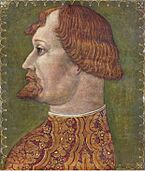
Gian Galeazzo Visconti (1400–1402)
After Michelotti's death, the city faced problems. People wanted a strong leader to protect Perugia and help with its debts. On January 21, 1400, Gian Galeazzo Visconti was named the lord of Perugia. He was the Duke of Milan. He canceled the city's debt. His rule was short, as he died on October 3, 1402.
Braccio da Montone (1416–1424)
In 1408, the King of Naples tried to make Braccio Fortebracci rule Perugia. Braccio refused. In 1411, Perugia gave up to the King of Naples instead. Braccio felt betrayed and left. In 1416, he returned with a large army and attacked Perugia. After a victory in July, Perugia surrendered to him.
Braccio ruled fairly. He was later made a Vicar by the Pope. He started public works in Perugia. He died in 1424 during a siege in L'Aquila. His son later buried him with honors in Perugia.
The Renaissance in Perugia
The Baglioni Family (1438–1540)
The Baglioni family had a hidden control over Perugia from 1438 to 1479. Braccio I Baglioni, a military captain and nephew of Braccio da Montone, became very powerful. During this time, Perugia grew and became more beautiful. The Baglioni family built new roads and palaces.
The Palazzo dei Priori was made bigger between 1429 and 1433. New churches and chapels were built. The Baglioni family supported artists like Piero della Francesca, Pinturicchio, and Raphael. This made Perugia an important art center.
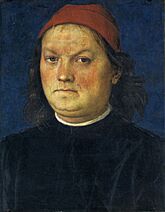
Perugia became a key place for the Umbrian Renaissance. Artists like Perugino created many works in the city. He painted frescoes in the Hall of Audiences of the Collegio del Cambio. The Baglioni family also built a large private palace. Only a part of it, now in the Rocca Paolina, remains.
In 1797, French troops took over Perugia. On February 4, 1798, the Tiberina Republic was formed. Perugia was its capital. In 1799, it joined the Roman Republic.
Perugia was hit by earthquakes in 1832, 1838, and 1854. In 1849, the Austrians took control. In June 1859, the people rebelled against the pope's rule. But the pope's troops stopped the uprising. In September 1860, Perugia became part of the Kingdom of Italy. During World War II, the city was not badly damaged. The British army freed it on June 20, 1944.
Perugia's Economy
Perugia is famous for its chocolate. This is mostly thanks to the company Perugina. Their Baci ("kisses") chocolates are sold all over the world. Perugian chocolate is very popular in Italy. The Perugina factory in San Sisto is the largest of Nestlé's factories in Italy.
The city hosts a chocolate festival every October.
Geography and Climate
Perugia is the capital of the Umbria region in central Italy. Here are some distances from Perugia:
- Assisi: 19 km (12 mi)
- Siena: 102 km (63 mi)
- Florence: 145 km (90 mi)
- Rome: 164 km (102 mi)
Perugia's Climate
Perugia has a humid subtropical climate. This means summers are warm to hot and humid. Winters are cold with some snow. There are not huge differences between high and low temperatures. It rains enough throughout the year.
| Climate data for Perugia (1971–2000, extremes 1967–present) | |||||||||||||
|---|---|---|---|---|---|---|---|---|---|---|---|---|---|
| Month | Jan | Feb | Mar | Apr | May | Jun | Jul | Aug | Sep | Oct | Nov | Dec | Year |
| Record high °C (°F) | 17.3 (63.1) |
21.7 (71.1) |
25.6 (78.1) |
29.7 (85.5) |
35.0 (95.0) |
37.5 (99.5) |
46.6 (115.9) |
38.9 (102.0) |
35.3 (95.5) |
30.2 (86.4) |
24.0 (75.2) |
19.3 (66.7) |
46.6 (115.9) |
| Mean daily maximum °C (°F) | 8.9 (48.0) |
10.9 (51.6) |
14.1 (57.4) |
16.8 (62.2) |
22.1 (71.8) |
26.1 (79.0) |
30.0 (86.0) |
30.0 (86.0) |
25.5 (77.9) |
19.7 (67.5) |
13.3 (55.9) |
9.3 (48.7) |
18.9 (66.0) |
| Daily mean °C (°F) | 4.8 (40.6) |
6.0 (42.8) |
8.4 (47.1) |
11.0 (51.8) |
15.7 (60.3) |
19.4 (66.9) |
22.6 (72.7) |
22.8 (73.0) |
19.2 (66.6) |
14.4 (57.9) |
8.9 (48.0) |
5.5 (41.9) |
13.2 (55.8) |
| Mean daily minimum °C (°F) | 0.6 (33.1) |
1.1 (34.0) |
2.6 (36.7) |
5.1 (41.2) |
9.3 (48.7) |
12.6 (54.7) |
15.2 (59.4) |
15.6 (60.1) |
12.8 (55.0) |
9.1 (48.4) |
4.4 (39.9) |
1.8 (35.2) |
7.5 (45.5) |
| Record low °C (°F) | −15.8 (3.6) |
−17.0 (1.4) |
−8.3 (17.1) |
−5.0 (23.0) |
−1.9 (28.6) |
5.2 (41.4) |
6.9 (44.4) |
6.0 (42.8) |
3.6 (38.5) |
−1.4 (29.5) |
−8.2 (17.2) |
−14.8 (5.4) |
−17.0 (1.4) |
| Average precipitation mm (inches) | 52.7 (2.07) |
56.8 (2.24) |
54.0 (2.13) |
72.0 (2.83) |
75.6 (2.98) |
69.9 (2.75) |
37.4 (1.47) |
49.7 (1.96) |
87.6 (3.45) |
85.7 (3.37) |
94.7 (3.73) |
68.4 (2.69) |
804.5 (31.67) |
| Average precipitation days (≥ 1.0 mm) | 7.1 | 7.1 | 7.0 | 8.7 | 8.4 | 7.1 | 4.7 | 4.9 | 6.5 | 7.7 | 8.4 | 7.8 | 85.4 |
| Average relative humidity (%) | 83 | 77 | 73 | 74 | 74 | 71 | 68 | 69 | 71 | 76 | 82 | 85 | 75 |
| Source: Servizio Meteorologico (humidity 1968–1990) | |||||||||||||
People of Perugia
| Historical population | ||
|---|---|---|
| Year | Pop. | ±% |
| 1861 | 42,515 | — |
| 1871 | 49,507 | +16.4% |
| 1881 | 50,718 | +2.4% |
| 1901 | 60,822 | +19.9% |
| 1911 | 66,277 | +9.0% |
| 1921 | 72,404 | +9.2% |
| 1931 | 77,352 | +6.8% |
| 1936 | 82,407 | +6.5% |
| 1951 | 95,310 | +15.7% |
| 1961 | 112,511 | +18.0% |
| 1971 | 129,921 | +15.5% |
| 1981 | 142,348 | +9.6% |
| 1991 | 144,732 | +1.7% |
| 2001 | 149,125 | +3.0% |
| 2011 | 162,449 | +8.9% |
| 2021 | 162,362 | −0.1% |
| Source: ISTAT | ||
In 2007, about 163,287 people lived in Perugia. About 47.7% were male and 52.3% were female. Children (under 18) made up 16.41% of the population. People over retirement age were 21.51%. The average age of people in Perugia is 44.
Between 2002 and 2007, Perugia's population grew by 7.86%. Most people (90.84%) in 2006 were Italian. The largest groups of immigrants came from other European countries. Most people in Perugia are Roman Catholic.
Learning and Education
Perugia has two main universities. The first is the old Università degli Studi. The second is the Foreigners University. This school teaches Italian language and culture to students from around the world.
Other schools include the Perugia Fine Arts Academy. It was founded in 1573. There is also the Perugia Music Conservatory for classical music. The Umbra Institute is a program for American students studying abroad. The Università dei Sapori (University of Tastes) is a national center for food education.
Frazioni: Towns and Villages
The comune (municipality) of Perugia includes many smaller towns and villages. These are called frazioni. Some of them are Bagnaia, Bosco, Capanne, and Castel del Piano. Other places include Fontignano, Mugnano, and Ponte San Giovanni.
Collestrada is near Ponte San Giovanni. A battle happened there in 1202 between people from Perugia and Assisi.
Amazing Places to See
Churches in Perugia
- Cathedral of S. Lorenzo: A beautiful main church.
- San Pietro: A church and abbey from the late 1500s.
- San Domenico: This large church began being built in 1394. It was finished in 1458. It has a huge stained glass window, one of the biggest in the world.
- Sant'Angelo: Also called San Michele Arcangelo. This small, old Christian church is from the 400s or 500s. It has a round shape.
- San Ercolano: A 14th-century church that looks like a tower. Its upper floor was removed when the Rocca Paolina was built.
- Santa Giuliana: A church and monastery founded in 1253. It was later used as a granary by French forces. Now, it is a military hospital.
- San Bevignate: A church that belonged to the Knights Templar.
Important Buildings
- The Palazzo dei Priori: This is the Town Hall and one of Italy's greatest buildings. It includes the Collegio del Cambio with frescoes by Pietro Perugino.
- Fontana Maggiore: A beautiful medieval fountain. It was designed by Fra Bevignate and sculpted by Nicola and Giovanni Pisano.
- Chapel of San Severo: This chapel has a fresco painted by Raphael and Perugino.
- The Rocca Paolina: A Renaissance fortress built between 1540 and 1543. Only a part of it remains today.
- Orto Botanico dell'Università di Perugia: The university's botanical garden.
Medieval Towers
- Sciri's tower: This is the most famous tower left in Perugia. It is 42 meters (138 feet) tall and has a square shape. It was recently restored to its original colors.
- Torre del Cassero di Porta Sant'Angelo: This is the largest medieval city gate in Perugia. It was built for defense.
Ancient Discoveries
- The Hypogeum of the Volumnus family (Ipogeo dei Volumni): An Etruscan tomb chamber.
- Etruscan Well (Pozzo Etrusco): An ancient well from Etruscan times.
- National Museum of Umbrian Archaeology: This museum has one of the longest writings in the Etruscan language. It is called the Cippus perusinus.
- Etruscan Arch (also known as Porta Augusta): An Etruscan gate with Roman parts.
Modern Buildings
- Centro Direzionale (1982–1986): This is an administration center for the Umbria Region. It was designed by famous architect Aldo Rossi.
Art and Culture
Perugia has a rich history of art. The Early Renaissance painter Pietro Perugino created many masterpieces here. The famous High Renaissance artist Raphael also worked in Perugia.
Today, the Galleria Nazionale dell'Umbria in Perugia has many famous artworks. These include the Madonna with Child and six Angels by Duccio. The Collegio del Cambio is a well-preserved Renaissance building. It has a wonderful fresco by Pietro Perugino.
Festivals and Events
- The Umbria Jazz Festival: One of Europe's most important jazz festivals. It has been held every July since 1973.
- Sagra Musicale Umbra: A festival for classical and chamber music.
- The International Journalism Festival: Held every April.
- Eurochocolate: A chocolate festival and fair. It used to be in Perugia but is now held in Bastia Umbra in October.
- Music Fest Perugia: A music festival for young talented musicians, usually in the summer.
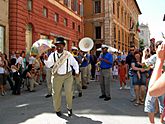 Umbria Jazz Festival 2008 |
 International Journalism Festival 2009 |
 Eurochocolate 2008 |
Famous People from Perugia
Many notable people have come from Perugia:
- Trebonianus Gallus (206–253): A Roman emperor.
- Bartolo da Sassoferrato (1314–1357): A famous medieval lawyer.
- Biordo Michelotti (1352–1398): A military leader.
- Braccio da Montone (1368–1424): Another military leader.
- Perugino (1450–1523): A famous painter.
- Pinturicchio (1454–1513): Another famous painter.
- Galeazzo Alessi (1512–1572): A well-known architect.
- Luisa Spagnoli (1877–1935): An entrepreneur who founded the Perugina chocolate company.
- Sandro Penna (1906–1977): A poet.
- Antonietta Stella (1929–2022): A famous opera singer.
Sports in Perugia
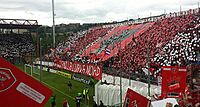
AC Perugia Calcio is the city's main football club. They play in Italy's second-highest division, Serie B. Their home is the Stadio Renato Curi, which holds 28,000 fans. It is named after a player who died during a match.
Perugia also has two water polo teams: L.R.N. Perugia and Gryphus. The L.R.N. Perugia team is in the second-highest division. They also have a women's water polo team in the same division.
Sir Safety Umbria Volley is a top-level Italian volleyball club. They won their first Italian championship in 2018. Famous players like Luciano de Cecco and Wilfredo Leon have played for them.
Martial arts have been popular in Perugia since the 1960s. These include Chinese techniques, judo, karate, and taekwondo. In 2014, Jessica Scricciolo won the World Champion title in Ju-Jitsu. In 2015, Andrea Calzon' won a gold medal in Ju-Jitsu at the World Championship in Greece.
Getting Around Perugia
Perugia used to have an electric tramway from 1901 to 1940. It was replaced by buses. Since 1971, the city has limited car traffic in the center. Large parking lots are available outside the city. From there, people can use public transport to reach the center.
The city has several elevators and escalators to help people get up the hills.
- Elevators: Mercato Coperto – Terrazza Mercato Coperto, Galleria Kennedy – Mercato Coperto.
- Escalators: Rocca Paolina, Cupa-Pellini, Piazzale Europa, Piazzale Bellucci.
Since 2008, an automated train system called Minimetrò has been running. It has seven stations. One end is at a large parking lot, and the other is in the city center.
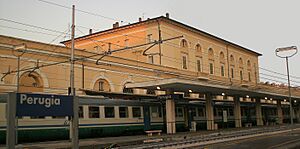
The main railway station is Perugia Fontivegge. It opened in 1866. It connects Perugia to cities like Florence and Rome. The station is about 3 kilometers (1.9 miles) southwest of the city center.
Perugia San Francesco d'Assisi – Umbria International Airport is 12 kilometers (7.5 miles) outside the city. There are also daily bus connections to and from Rome Fiumicino Airport.
Perugia's Sister Cities
Perugia has special connections with other cities around the world. These are called twin towns or sister cities.
 Aix-en-Provence, France
Aix-en-Provence, France Bratislava, Slovakia (since 1962)
Bratislava, Slovakia (since 1962) Grand Rapids, U.S.
Grand Rapids, U.S. Potsdam, Germany
Potsdam, Germany Seattle, U.S.
Seattle, U.S. Tübingen, Germany
Tübingen, Germany
Images for kids
See also
 In Spanish: Perugia para niños
In Spanish: Perugia para niños


